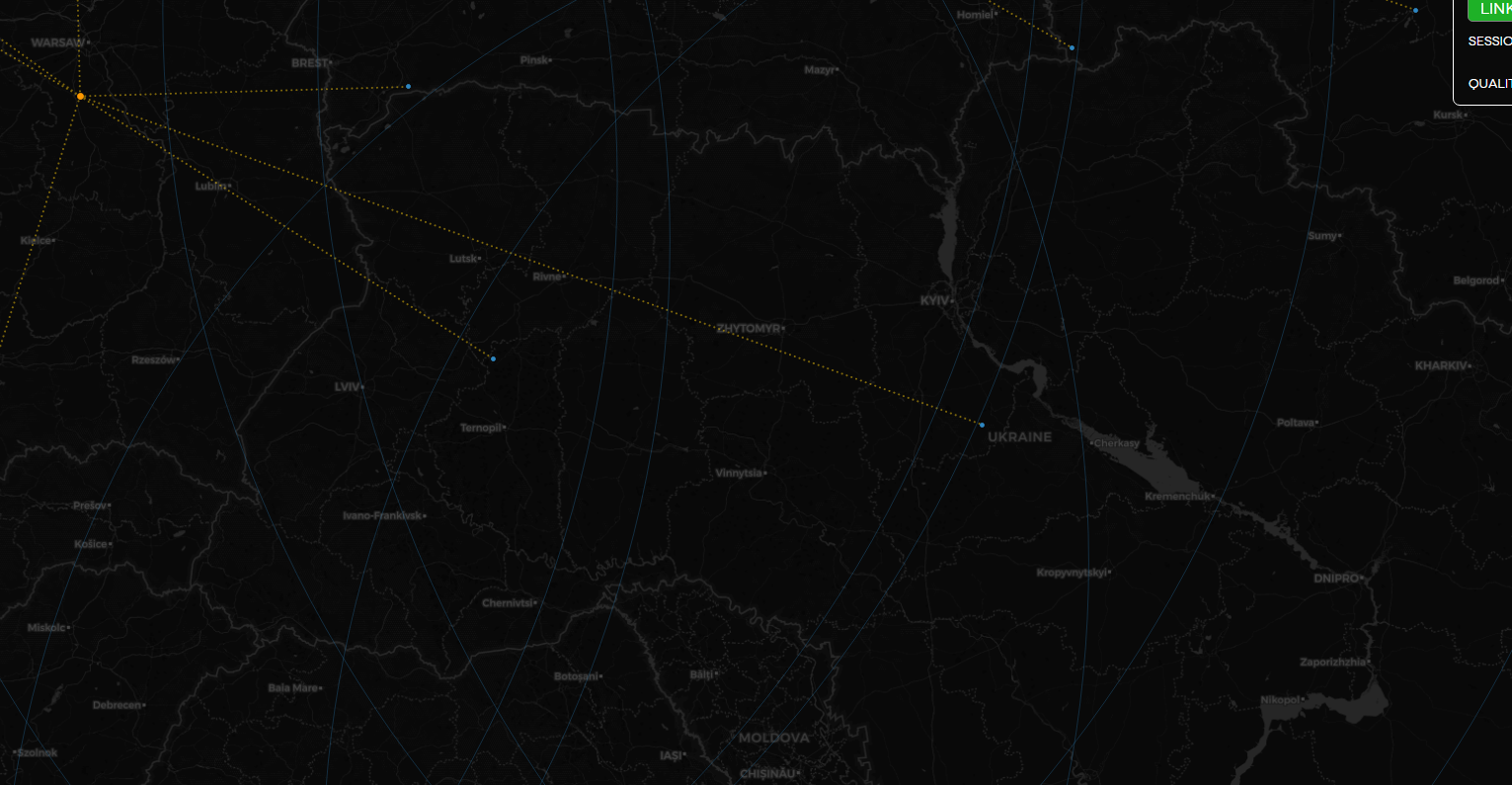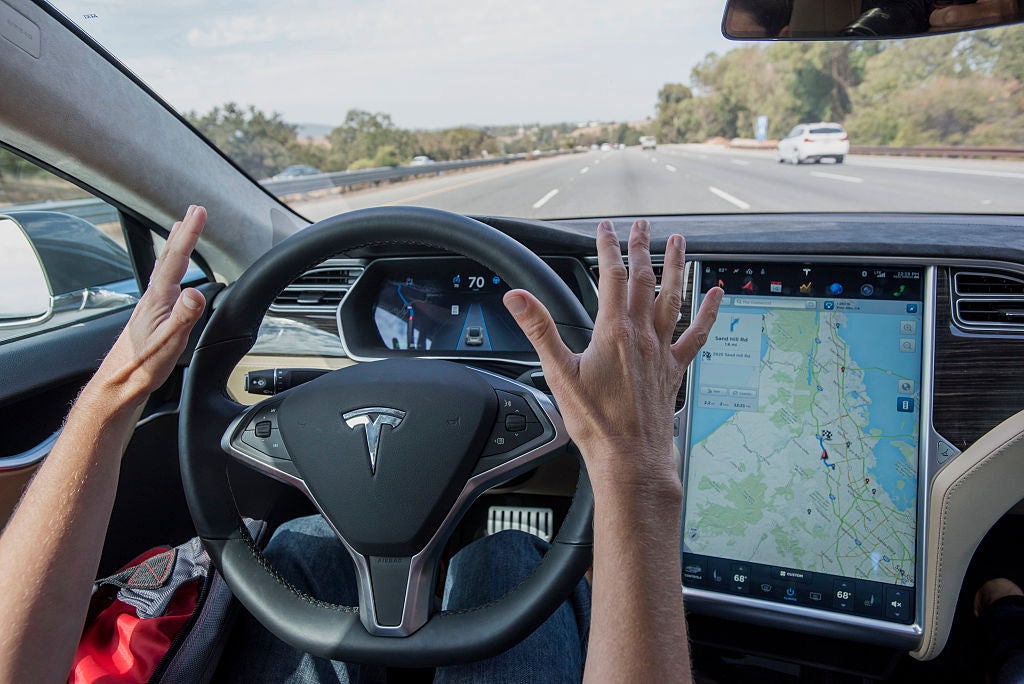
Tech billionaire Elon Musk has thrown open his Starlink satellite broadband system to the embattled people of Ukraine and sent ground terminals for them to use. Is this genuine significant help, or merely a gesture – or even worse, could Starlink be dangerous to Ukrainian users?
To answer this question, it helps to understand what Starlink is and how it differs from other satellite systems. Starlink today is a constellation of more than 1,500 satellites orbiting the Earth, of which around 1,400 are operational at any given time. It is operated by SpaceX, Musk’s space venture, which is unusual among billionaires’ private space ventures in actually being able to do things in space.
Unlike most communication satellites, Starlink spacecraft are in low orbit just 550km up. This means that seen from the ground in Ukraine they move rapidly across the sky from West to East, passing over the entire country in a matter of minutes. Typically there will be three to five operational Starlink spacecraft above Ukrainian territory at any given time.
A satellite at 550km altitude actually rises above the horizon while it is still more than 2,500km away from a user on the ground, but that doesn’t mean it provides a service at that point. Starlink ground terminals need a satellite to be well above the horizon, high in the sky, before they can connect to it. So Starlink users on the ground in Ukraine need to connect to satellites flying relatively close, though not necessarily above their own country.
The Starlink “pizza box” phased array on the ground connects to the satellite by forming a directional “beam” which it locks on to the spacecraft, tracking it across the sky. This technology, largely unique to Starlink in satcomms for the moment, permits the ground-to-space connection to be a high capacity, low latency broadband link.
Other low-orbit systems such as Iridium cannot aim a beam at the satellite and have to use omnidirectional broadcast radio, which limits them to very narrowband service indeed: no better than long-outmoded 2G mobile.
How well do you really know your competitors?
Access the most comprehensive Company Profiles on the market, powered by GlobalData. Save hours of research. Gain competitive edge.

Thank you!
Your download email will arrive shortly
Not ready to buy yet? Download a free sample
We are confident about the unique quality of our Company Profiles. However, we want you to make the most beneficial decision for your business, so we offer a free sample that you can download by submitting the below form
By GlobalDataHigh-orbiting geostationary satellites which sit still in the sky can easily achieve broadband capacity if the user can train a large fixed dish on them, but they are so far out in space that the connection will have severe latency problems – bad enough to make it problematic for real-time uses such as phone or video calls. And, as we shall see, geostationary satellites are fairly easy for Russia to jam.
For now, only Starlink offers decent, probably Putin-proof, broadband service from space. And the first lorry load of ground terminals dispatched by Musk free of charge arrived in Ukraine on February 28th.
As the huge Russian invasion army slowly grinds its way across Ukraine, it’s to be expected that cities and other areas of resistance will be surrounded, and that groundbased backbone links will be cut off. In the coming days and weeks, it’s likely that president Volodymyr Zelensky and other Ukrainians will have to resort increasingly to satellite communications to remain in touch with the outside world – and in many cases with each other. Starlink can, indeed, help with this.
Can Starlink be hazardous to your health?
But there are some caveats to the aid provided by the world’s richest man. Musk himself has tweeted that:
“Starlink is the only non-Russian communications system still working in some parts of Ukraine, so probability of being targeted is high. Please use with caution.”
The problem here is that the tracking radio “beam” generated by the ground terminal is not something narrow like a laser.
“It’s more of a cone than a beam,” explains wireless communications expert Bill Ray, VP analyst for emerging technologies and trends at Gartner. “And like most directional radio systems, it will emit ‘lobes’ of radio transmission outside the main beam in other directions, too. You would have to be very close to it to detect it if you were on the ground, but suitably equipped aircraft or drones could locate a working Starlink ground station. And we know the Russians have this sort of equipment.”
Once Russian forces have a Starlink terminal located they might hit that location with artillery or missile strikes, or send troops to the spot, so Musk’s warning makes sense.
But Musk is trying to help with this issue.
“Mobile roaming enabled, so phased array antenna can maintain signal while on moving vehicle,” he tweeted.
Starlink boxes as shipped to normal consumers are intended for home use at a fixed location, but evidently Musk is remotely modifying the software in Ukrainian boxes so that they can work while in motion. There’s nothing technically unfeasible about this, as the beam can swivel fast enough to stay on a satellite moving across the sky at 30,000km an hour: the velocity of a car or truck shouldn’t be too much of a problem by comparison.
“The US military actually did a trial in which they achieved 600 megabits per second (Mbps) using Starlink from a Cessna aeroplane in flight,” Ray tells Verdict. “They used more than one terminal but it shows what can be done.”
Musk has also issued software amends designed to reduce the Starlink ground terminals’ power consumption. They’re normally intended to run on a domestic wall socket, but Musk has tweeted that it will be feasible to power them from 12-volt car sockets if necessary, making it much easier to use them on the move.
It’s a hugely more difficult task for the Russian forces to strike a moving target with artillery or most kinds of bomb or missile than hitting a fixed location, and ground troops would also face a tougher challenge trying to shut down mobile terminals. Musk’s modifications, if they work, will make Starlink much safer for the Ukrainians to use.
Elon Musk’s pipe is bent
There is, however, the issue of coverage to consider.
“Starlink is still strictly ‘bent pipe’ at the moment,” comments Ray.
This means that Starlink satellites can’t communicate with each other and so pass a signal around the world using space-to-space links. The system is intended to achieve this in future, but for the moment each satellite has to pass the signals it receives from Ukrainian ground terminals to another ground “gateway” station beneath it, in order to get the data into the worldwide internet.
The fascinating starlink.sx website set up by “technologist, firefighter, entrepreneur and hacker” Mike Puchol – which has no affiliation with Musk or Starlink – shows every Starlink satellite as it moves around the world in near real time. Even more interestingly, it shows which ground gateway the satellite is passing its data through, if it is connected to one.
As the Starlink spacecraft arrive over the western Ukraine they are mostly hooked up to ground stations in Poland and Lithuania, though some on more southerly paths connect via Turkey at times. The satellites remain connected as they move over western and central Ukraine, meaning that they will definitely offer reliable service to the capital Kyiv and surrounding regions. As they reach the eastern Ukraine, however, they lose their connection in the neighbourhood of Kharkiv. Musk has no operating ground bases anywhere on the continent beyond that point, so his satellites mostly remain disconnected until they have orbited onward and crossed the Pacific.
But Starlink ground terminals in besieged Kharkiv should be able to reach still-connected satellites to the west of the city: starlink.sx indicates that Musk’s coverage probably reaches well into Russia, in fact.
As the Russian army moves deeper into Ukraine, then, it does indeed seem likely that Starlink will, more and more, be the main or only longer range communications option for Ukrainians. Ray points out that this is not necessarily limited only to those in possession of a Starlink ground terminal: there will be many ways to share a Starlink connection across various kinds of local ground network, perhaps offering some connection to the worldwide internet to considerable numbers of Ukrainians from each terminal. This would not only let them communicate with the outside world, of course, but with other such pockets of connectivity elsewhere in the country.
It’s not surprising that the Russians aren’t happy at this prospect, and have stated that they regard Starlink equipment as a valid military target. Meanwhile the Ukrainian Vice Prime Minister Mykhailo Fedorov has thanked Musk for his efforts.
But could the Russians cut off Starlink by other means than chasing down the ground terminals? Perhaps not, or not easily anyway. A normal, geostationary communications satellite has the disadvantage that it is easy to target: and not just by simply destroying it, an unlikely tactic. It’s a relatively simple matter to aim a powerful, directional radio signal at a geostationary satellite sitting still in the sky, which will tend to overload its receivers and prevent it from picking up ground terminal signals from anywhere near the jamming signal.
Jamming a Starlink satellite, by contrast, would require a much more sophisticated operation which could track multiple spacecraft as they zoomed past.
“We’ve already seen interference with geostationary ViaSat communications in the area,” comments Ray, “which is assumed to be Russian action. But Starlink, with its fast-moving directional signals and satellites, will be considerably more difficult to jam.”
Musk is genuinely helping here
Elon Musk has a penchant for jumping into arising high-profile situations with comments and – often enough – offers of help or action. Sometimes interventions by Musk appear ill-judged at best, as when he stepped into the crisis of the Thai schoolchildren trapped in a flooded cave in 2018. His offer to lend a submarine to the rescue efforts turned out not to be a useful one, and the insult he offered to one of the divers involved resulted in legal action.
But today things seem very different. With Starlink Musk has built a largely unique capability. Starlink’s ability to provide high-capacity links to the global internet without ground infrastructure is likely to prove hugely important to the Ukrainians in their struggle against the Russian takeover. Musk’s on-the-fly efforts to adapt the Starlink terminals for mobile and covert use illustrate the technical competence of his company SpaceX, and – if they work – will make the equipment hugely more useful.
This time, it really looks as though Musk has got one right.







